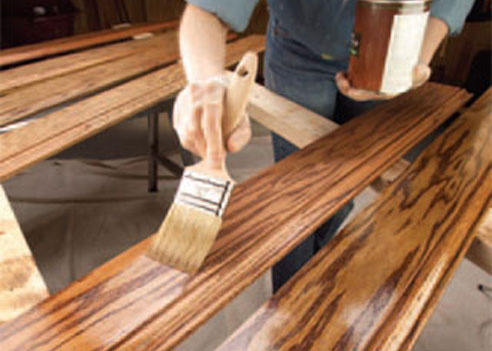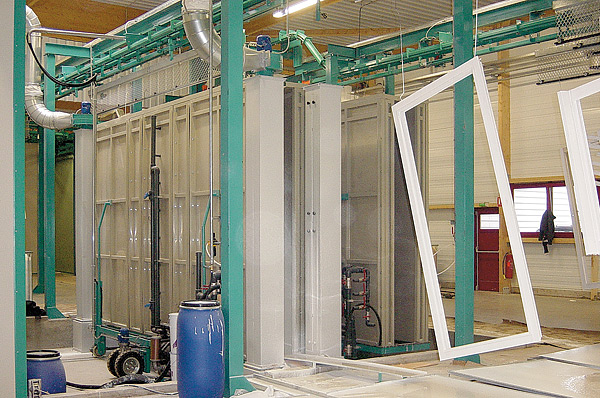As a continuation of the article Wood staining solutions, I will tell you about the methods of applying the bath and how they influence the final appearance of the coloured object.
Staining solutions can be applied by various methods: by cloth, brush, brush, in special mills, by dipping, spraying, pouring, flow-coating or by combining several methods. There are situations where applying the same stain by two different methods produces different results. Therefore, the methods of applying the bath must be chosen according to the desired result. Also, not all staining solutions can be applied by every method. The technical data sheets of professional staining products always specify how to apply them.

Application of baitto in DIY projects
If it's a DIY project - occasional coloured wooden objects - the application of the stain is done with a brush, cloth, brush, trowel or sponge. When a small amount is applied - cloth and sponge well wrung out, brush well shaken - the wood will be surface stained, and the stain will be more even and without bringing out the pores or natural pattern of the wood.
Applying a larger amount of wood stain will absorb more of the wood and thus highlight its design. Staining must be done carefully because there is a risk of staining due to the higher absorption in the area where you start (where you first put the cloth or brush soaked in the berry).
It can be evenly stained, marking the pores at the same time, applying the excess bath and then wiping off the excess with a cloth. Wiping is done initially in circular motions, then in straight motions along the grain. The uniformity of the staining also depends very much on how it was done white grinding.
The trafalet sponge may be sensitive to solvents. If you are going to work with solvent-based baths, choose a trafalet with a special solvent-resistant sponge. The same applies if you are going to apply the sponge bath. If an ordinary sponge comes into contact with organic solvents it will start to dissolve and deform (broaden), making it unusable in a short time. Make sure you have the right tools before you start working.
Immersion application
If the objects are small, colouring can be done by imersie. It is a method that allows the wood to absorb a lot of solution and the objects become intensely coloured. This is why the method should not be used with objects made of loose, badly sanded wood or with many fibre ends (resulting from mechanical processing) that absorb a lot.
By dipping, wooden objects can be stained uniformly and which are highly polished. To avoid staining it is best to use staining solutions specially formulated for such applications.
Spray application
Spraying is the method by which you can achieve more than one result with the same bath. Using a staining solution made in a fast solvent and applying a small amount will give a uniform, surface stain. This method is recommended for staining wood with a difference in colour between fibres or wood with different absorbency. This also makes the staining uniform if stains have appeared after the application of the bath.
If a small amount of a compatible, highly volatile solvent is added, the same stain solution, applied in excess and wiped off with a cloth, will result in marked pores and highlighting of the wood's natural pattern. Water-soluble stains or those formulated in a medium-low solvent, applied in a moderate amount, will be absorbed more into the wood, will bring out the wood's pattern without very obviously marking the pores. The quantity is adjusted by opening the gun nozzle and increasing or decreasing the pressure.

photo source: browseblog.com

photo source: ceflafinishinggroup.com
Industrial applications
In the industry, the methods of applying the bath rely heavily on machinery. Pore marking can be done, for example, by applying baths with valve application machines. In this case the bath must be specially formulated, to have consistency, to allow such an application.
Small objects can be uniformly coloured in special dies. The mills are like drums into which the pieces are inserted and the staining solution is sprayed, while the pieces are continuously turned inside. Absorption is uniform, drying is fast (there are air currents inside), and the result is uniform colouring.
In large factories, where laminated wood windows are produced, there are complex finishing lines. The staining method most often used on such lines is flow-coating. The windows, hung by chains, are passed into the tinting area through an installation that applies the tinting solution like a shower, and the surplus collects at the bottom and is recirculated. Specially formulated solutions must be used for uniform staining. Excess air should also be avoided as this leads to foaming of the solution.

photo source: imtechnology.nl
To stain wood the way we want it, we need to have good staining solutions and choose the right method and tools. And the most important thing - to be made a very good white grinding.
I hope you find the above information useful. As usual, additions are welcome. And if you have any questions or queries, please leave them in the space below. I'm sure I'll reply.


























Add comment